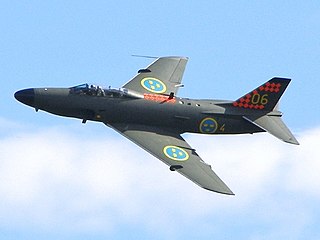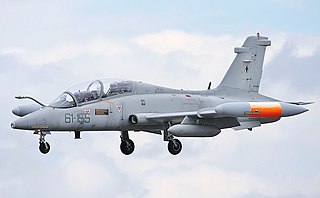
The Aermacchi or Macchi MB-326 is a light military jet trainer designed and produced by the Italian aircraft manufacter Aermacchi. It is one of the most commercially successful aircraft of its type, being bought by more than 10 countries and produced under licence in Australia, Brazil and South Africa.

The CASA C-101 Aviojet is a low-wing single engine jet-powered advanced trainer and light attack aircraft designed and manufactured by Spanish aircraft company Construcciones Aeronáuticas SA (CASA).

The Saab 32 Lansen is a two-seat, transonic military aircraft designed and manufactured by the Swedish aircraft manufacturer Saab AB.

The AMX International AMX is a ground-attack aircraft jointly developed by Brazil and Italy. The AMX is designated A-11 Ghibli by the Italian Air Force and A-1 by the Brazilian Air Force. The Italian name, "Ghibli", is taken from the hot dry wind of the Libyan desert.

The Dassault Mirage 2000N is a variant of the Mirage 2000 designed for nuclear strike. It formed the core of the French air-based strategic nuclear deterrent. The Mirage 2000D is its conventional attack counterpart.

The Saab 105 is a Swedish high-wing, twinjet trainer aircraft developed in the early 1960s as a private venture by Saab AB. The Swedish Air Force, which had opted to procure the type for various roles, issued the aircraft with the designation Sk 60. The Sk 60 entered service in 1967, replacing the ageing De Havilland Vampire fleet.

The Aermacchi MB-339 is a military jet trainer and light attack aircraft designed and manufactured by Italian aviation company Aermacchi.

The Aermacchi M-346 Master is a family of military twin-engine transonic advanced jet trainers and light combat aircraft. Originally co-developed with Yakovlev as the Yak/AEM-130, the partnership was dissolved in 2000 and then Alenia Aermacchi proceeded to separately develop the M-346 Master, while Yakolev continued work on the Yakovlev Yak-130. The first flight of the M-346 was performed in 2004. The type is currently operated by the air forces of Italy, Israel, Singapore, Greece, Turkmenistan and Poland. Since 2016 the manufacturer became Leonardo-Finmeccanica as Alenia Aermacchi merged into the new Finmeccanica, finally rebranded as Leonardo in 2017.

The Aero L-159 ALCA is a subsonic light combat aircraft and advanced trainer developed in the single-seat L-159A and two-seat L-159B versions, respectively, produced in the Czech Republic by Aero Vodochody. It was derived from the Aero L-59 Super Albatros trainer, which was in turn developed from the Aero L-39 Albatros series.

The Fuji T-1 Hatsutaka was Japan's first jet-powered trainer aircraft. Its first flight was in January 1958. A total of 66 T-1 planes were built. It was retired in March 2006.

The BAC 167 Strikemaster is a British jet-powered training and light attack aircraft. It was a development of the Hunting Jet Provost trainer, itself a jet engined version of the Percival Provost, which originally flew in 1950 with a radial piston engine.

The Mitsubishi F-1 is a Japanese swept-wing, single-seat, twin-engine supersonic strike aircraft that was in service with the Japan Air Self-Defense Force (JASDF) from 1978 to 2006. It was Japan's first domestically designed and built supersonic combat aircraft, jointly developed by Mitsubishi Heavy Industries. It is essentially a T-2 trainer airframe modified for a dedicated anti-ship and ground attack role.

The Soko G-4 Super Galeb, also referred to as N-62, is a Yugoslav single-engine, advanced jet trainer and light ground-attack aircraft designed by the Aeronautical Technical Institute at Žarkovo and manufactured by the SOKO aircraft factory in Mostar.

The AIDC AT-3 Tzu Chung is an advanced jet trainer operated by the Republic of China Air Force (ROCAF). A total of sixty-two aircraft were manufactured by the Aerospace Industrial Development Corporation of Taiwan in collaboration with American aircraft manufacturer Northrop between 1984 and 1990. Two A-3 single-seat attack version were also built.

The Saab 18 was a twin-engine bomber and reconnaissance aircraft, designed and built by Svenska Aeroplan AB (SAAB) for use by the Swedish Air Force in response to a 1938 design competition. Due to delays, it did not enter service until 1944, but quickly became the standard Swedish bomber aircraft. Serving in the bomber, reconnaissance and ground-attack roles, it also assisted in the development of ejection seats and air-to-surface guided missiles until its replacement by the Saab Lansen in the late 1950s.

The Guizhou JL-9, also known as the FTC-2000 Mountain Eagle, is a family of two-seat transonic advanced jet trainer and light combat aircraft developed by the Guizhou Aviation Industry Import/Export Company (GAIEC) for the People's Liberation Army Air Force (PLAAF) and the People's Liberation Army Naval Air Force (PLANAF).

The Aermacchi M-345 is a turbofan-powered military trainer aircraft designed and produced by the Italian defense conglomerate Leonardo S.p.A.

The KB SAT SR-10 is a prototype Russian single-engine jet trainer aircraft, fitted with forward-swept wings. It first flew in 2015 and is being offered to the Russian Air Force and for export.

The AIDC T-5 Brave Eagle is a transonic advanced jet trainer and light attack aircraft developed by the Aerospace Industrial Development Corporation (AIDC) of Taiwan.

The TAI Hürjet is a single-engine, tandem seat, supersonic advanced jet trainer and light combat aircraft, under development by Turkish Aerospace Industries (TAI). The first prototype made its first flight on 25 April 2023.




















